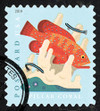
# 5365 - 2019 35c Coral Reefs: Pillar Coral
US #5365
2019 Pillar Coral – Coral Reefs (Sheet Stamp)
• One of four stamp designs picturing different species of coral and aquatic animals that call reefs home
Stamp Category: Definitive
Set: Coral Reefs
Value: 35¢ Postcard Rate
First Day of Issue: March 29, 2019
First Day City: St. Louis, Missouri
Quantity Issued: 125,000,000
Printed by: Ashton Potter (USA) Ltd.
Printing Method: Offset, Microprint
Format: Panes of 20
Tagging: Nonphosphored Type III, Block Tag
Why the stamp was issued: To cover the postcard rate and celebrate the beauty and diversity of coral reefs.
About the stamp designs: Pictures stylized artwork by Tyler Lang of a coney grouper and neon gobies with pillar coral.
First Day City: First Day of Issue Ceremony held at the St. Louis Stamp Expo (March 29-31) in St. Louis, Missouri.
About the Coral Reefs set: Four stamps picturing stylized artwork by Tyler Lang of assorted fish with elkhorn, brain, staghorn, and pillar coral. Raises awareness for the plight of coral reef ecosystems across the globe due to climate change and human disturbances.
History the stamp represents: Climbing up from the sea floor and reaching out of the reef like fingers, pillar coral are unlike other coral in several ways.
One of the most notable differences between pillar coral and other hard coral is that pillar coral feed during the day. Most other hard coral feed only at night. With their mass of tentacles stretched out in the water, they often appear furry. Pillar coral also differ from other species in that they are not hermaphroditic (carrying both male and female reproductive organs). Instead, some pillars are male and some are female.
Pillar coral are mostly found in the Atlantic and the Caribbean. They can reach a height of 10 feet with pillars over four inches wide. They grow slowly and can withstand strong waves, but are prone to breaking in hurricanes and tropical storms. However, if pillars break off, they can attach themselves to the ground, allowing for new pillars to grow. This can happen over generations, creating massive pillars.
Pillar coral are considered a vulnerable species, as their numbers have decreased and there are few juvenile coral in the wild. But in recent years, scientists have successfully bred and raised pillar coral in a lab. They hope to study these coral to better understand them, help them become more resilient, and possibly introduce them into the reefs to help restore their numbers.
US #5365
2019 Pillar Coral – Coral Reefs (Sheet Stamp)
• One of four stamp designs picturing different species of coral and aquatic animals that call reefs home
Stamp Category: Definitive
Set: Coral Reefs
Value: 35¢ Postcard Rate
First Day of Issue: March 29, 2019
First Day City: St. Louis, Missouri
Quantity Issued: 125,000,000
Printed by: Ashton Potter (USA) Ltd.
Printing Method: Offset, Microprint
Format: Panes of 20
Tagging: Nonphosphored Type III, Block Tag
Why the stamp was issued: To cover the postcard rate and celebrate the beauty and diversity of coral reefs.
About the stamp designs: Pictures stylized artwork by Tyler Lang of a coney grouper and neon gobies with pillar coral.
First Day City: First Day of Issue Ceremony held at the St. Louis Stamp Expo (March 29-31) in St. Louis, Missouri.
About the Coral Reefs set: Four stamps picturing stylized artwork by Tyler Lang of assorted fish with elkhorn, brain, staghorn, and pillar coral. Raises awareness for the plight of coral reef ecosystems across the globe due to climate change and human disturbances.
History the stamp represents: Climbing up from the sea floor and reaching out of the reef like fingers, pillar coral are unlike other coral in several ways.
One of the most notable differences between pillar coral and other hard coral is that pillar coral feed during the day. Most other hard coral feed only at night. With their mass of tentacles stretched out in the water, they often appear furry. Pillar coral also differ from other species in that they are not hermaphroditic (carrying both male and female reproductive organs). Instead, some pillars are male and some are female.
Pillar coral are mostly found in the Atlantic and the Caribbean. They can reach a height of 10 feet with pillars over four inches wide. They grow slowly and can withstand strong waves, but are prone to breaking in hurricanes and tropical storms. However, if pillars break off, they can attach themselves to the ground, allowing for new pillars to grow. This can happen over generations, creating massive pillars.
Pillar coral are considered a vulnerable species, as their numbers have decreased and there are few juvenile coral in the wild. But in recent years, scientists have successfully bred and raised pillar coral in a lab. They hope to study these coral to better understand them, help them become more resilient, and possibly introduce them into the reefs to help restore their numbers.







